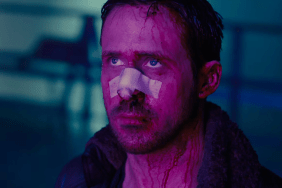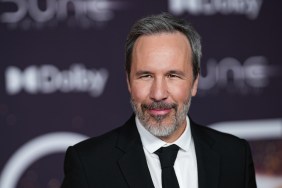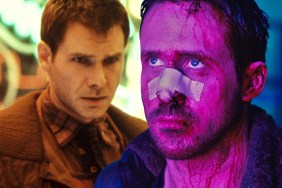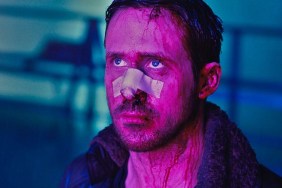
7 out of 10
Cast:
Ryan Gosling as Officer K
Harrison Ford as Rick Deckard
Ana de Armas as Joi
Sylvia Hoeks as Luv
Robin Wright as Lieutenant Joshi
Mackenzie Davis as Mariette
Carla Juri as Dr. Ana Stelline
Lennie James as Mister Cotton
Dave Bautista as Sapper Morton
Jared Leto as Niander Wallace
Barkhad Abdi as Doc Badger
David Dastmalchian as Coco
Hiam Abbass as Freysa
Wood Harris as Nandez
Tómas Lemarquis as File Clerk
Mark Arnold as Interviewer
Directed by Denis Villeneuve
Blade Runner 2049 Review:
When Beethoven would set to work on a new piece, the most important thought was what he called ‘development.’ Once he set out the theme at the heart of his symphony, he refused to sit back and return to it or repeat it, even one as original and powerful as the opening of the fifth symphony. Instead, he would change it — sometimes subtly, sometimes dramatically — because what would be the point of repeating the same thought over and over and over again?
Set 30 years after the first Blade Runner, Blade Runner 2049 introduces a world still on the cusp of falling apart and still relying on the slave labor of bioengineered Replicants who are still very hard to tell apart from humans, even to each other. Like a lot of sequels, the world of Blade Runner seems to have largely sat still over the intervening decades to make certain that it’s still recognizable to its fans.
A director taking on a sequel who is really interested in development has two choices: expand on the themes of the original (amid a new mise en scène) or expand on the world (amid a new storyline). Director Denis Villeneuve (Arrival) — taking over the franchise from initiator Ridley Scott — has chosen to split the difference. We get out of Los Angeles to see how the West Coast has reacted to the 21st Century, or at least out to San Diego (which has become a trash dump for Los Angeles) and Las Vegas (now a radioactive wasteland), but the environs and how people live in them change only slightly. The oft-mentioned colonies driving the creation of the Replicants and the problems of this world remain only an idea to drive the plot, along with any thought as to what the rest of the world looks like (if it exists at all).
That worked the first time out because the original film was a heavily-internalized story, strongly focused on the actions of just a few individuals and what those actions meant to those individuals, drawing universalities from those very specific experiences. Blade Runner 2049 has much grander designs, at least at a plot level. In the years since the first film, the Tyrell Corporation has been replaced by the much grander Wallace Corporation, which has created new generations of artificial humans, from intelligent holograms (de Armas) to Replicants so safe they can live their own lives on earth, even serve as police officers. But while the mercurial CEO of the Wallace Corp. (Leto) seeks to create more and more slave labor to fill humanity’s needs, some of his creations have begun to band together, seeing themselves as the next level of mankind and prepared to rise up against their creators.
RELATED: Blade Runner 2049 Interviews with Harrison Ford, Ryan Gosling & More!
It’s big, heady classic sci-fi stuff, but it’s been squashed down into a known context which keeps it from developing. Almost none of these big, heady expansions of theme are given any sort of conclusion, in part because they’ve got to make room for a very large, very conventional plot about a secret conspiracy to keep the current world order extend down to an over-the-top, one-dimensional, megalomaniacal villain in Leto and his Replicant right hand. Because what they think and want is pointless — they exist just to make the plot go — there is a lack of urgency or immediacy to Gosling’s Officer K or his search for the long-missing Blade Runner Rick Deckard (Ford). Hero and villain exist largely in a vacuum to one another; Villeneuve and screenwriters Hampton Fancher and Michael Green are less interested in using them to approach their questions about the nature of humanity than to place all of that on Gosling’s shoulders.
Beyond the brewing Replicant rebellion and the search for Deckard, K is involved in his own personal search for meaning in his own life as he toys with developing a relationship with the artificially-intelligent hologram he lives with even as his dissatisfaction with his work builds. It’s an interesting addition to the franchise’s core questions, but it buts up against all of the other approaches to the same theme the filmmakers are going with keeping any of them from developing fully. This go round is much more of the ‘throw as much as possible at the wall and see what sticks’ approach and it’s not only unsatisfying at a thematic level, it ultimately doesn’t work as a plot either as Villeneuve eventually has to start dropping threads without concluding them in order to get to a stopping point.
That it works as well as it does is largely thanks to Gosling, who carries Blade Runner 2049 around on his shoulders (Ford himself is more of a glorified cameo than a co-star) and does spectacular work holding K’s internal conflicts in right up until the seams to show. And the world expansion, when it does happen, is breathtaking. Villeneuve has teamed his regular cinematographer Roger Deakins with Skyfall and Spectre production designer Dennis Gassner to create the starkly-beautiful prosceniums Sam Mendes used so well in the recent James Bond films. It’s familiar without aping and always interesting to look at. The score by Benjamin Wallfisch and Hans Zimmer is no patch on Vangelis’ original but makes an excellent partner to Theo Green’s sound design; it combines into an engrossing sensory experience which begs to wash over you.
Blade Runner 2049 is really, really pretty and intermittently poses some interesting (if not entirely original) questions about where exactly the nature of humanity lies but at the expense of a compelling plot or a clear line of thought.









